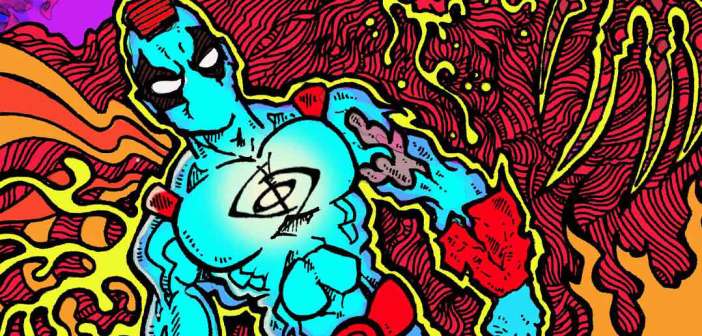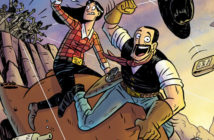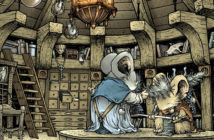Matt Rothblatt and Ben Perez, the founders of Phi3 Comics and the creators of their own original comic book SPIRALMIND, recently found the time to have a chat with me about their work in comics and the entrepreneurial business of independent publishing.
Steven Surman: Before we even dive in, how exactly is your company’s name, Phi3 Comics, pronounced?
Ben Perez: There is a lot of debate as to how “PHI” is pronounced. This is how we look at it: PHI (Φ) is a Greek letter and the letter PHI (Φ) is also used to denote the Electric Field Flux in electrical engineering and physics. The Greeks and my physics and engineering professors pronounced “PHI” as FEE. The number three (3) came from the three of us who originally put SPIRALMIND together: Matt, Joaquin Silva (the original artist), and I. Joaquin’s life just got to busy for SPIRALMIND at the time but we do owe him a lot in the development of the character. So putting it all together, we pronounce PHI as FEE and 3 is pronounced as three hence Phi3 (FEE-Three)!
SS: When was Phi3 founded? How did the company’s creation even come about?
Matt Rothblatt: I remember it well: It was the winter of 2003/2004. Ben called me up out of the blue one afternoon and said we were going to do a comic book. I laughed it off at first since neither one of us could draw. I let Ben tell me his idea anyway, and, as I began getting into the story, I remembered a guy at my work that did some comic book work back east (New England): Joaquin Silva. Suddenly, the light bulb went off! We CAN do this! Of course, I had to get Bruce Wayne/James Bond out of Ben’s mind when we began to develop the story further and SPIRALMIND was born. From SPIRALMIND came Phi3, the Phi representing the spiral from the “Golden Ratio” or “Divine Proportion”—a key element to the entire SPIRALMIND saga.
SS: How much energy did it take for you two to begin your own comic company?
BP: We already had the idea for SPIRALMIND, so the momentum of the story carried us towards the creation of the company.
MR: At first it was easy—the momentum drove us. In theory, we would write and Joaquin would draw, ink, and letter. Then Ben and I would put it all together. Unfortunately, life had other plans. Joaquin stepped aside about 1/3 of the way through the first issue and we were back to square one. Thankfully Ben found Brian Robinson online and we were back in business—for awhile. After getting nowhere with other letterers and graphic designers, I learned how to letter myself and finished the interior pages. The great Bill Fountain’s rendition of SPIRALMIND graced the cover and we had a comic book! In short, the energy was like a sine wave—we had our ups and downs, but we kept on track and ended up on top. The learning curve was (and still is) steep, but then again we’re engineers; we know how to bust curves!
SS: Who specifically came up with the story of SPIRALMIND?
BP: I did. I created the story first as a character/event, and later Matt, Joaquin, and I developed the character with the same name. At first the character was more like Cary Grant, a suave pristine character, but I was overruled. The event of SPIRALMIND, though, still remains intact.
MR: Ben had a suave playboy as Spiralmind’s alter ego, which had to go!
SS: Where did the idea come from?
BP: You know, this is really a difficult question that everybody asks me. In truth, I really don’t know where I came up with it. In fact, I often tell Matt that I believe SPIRALMIND chose me.
MR: From Ben’s initial idea, we began brainstorming looks, powers, temperament, etc., for each major character as well as the bad guys. Ben brought in the original premise; we all brought a piece of what you see today.
SS: SPIRALMIND is a rather unique narrative concept. Tell me about the process of developing the story.
BP: Well, Spiralmind is both an event and a character. Now, concerning the event, as the story develops there is a causal connection that the readers are allowed to witness. The characters of SPIRALMIND are forced into situations in which they must react. Those reactions in turn generate multiple events that the other characters are subjected to. The event Spiralmind creates a process that is relentless, like tidal waves hitting the characters over and over again. How they themselves respond is vital to the overall story because some of them will endure and others will be utterly destroyed. Spiralmind (as an event) generates a sort of matrix that is fluid but it does set limits in which the characters must navigate in order to not only survive but succeed. These causally related series of events make up the Spiralmind.
As for the character, Spiralmind himself is forced to respond to the relentless demands placed on him by both the other characters and the Spiralmind itself. He is neither willing to totally commit, nor willing to totally abandon situations or the other characters he feels responsible to; SPIRALMIND allows the readers to witness the human condition of the fear of commitment. It’s what eventually drives us all; the readers witness what it is that forces Spiralmind to commit, whether it is for a cause or another person. In the end, Spiralmind is forced to commit if he’s to succeed. Combining these two concepts allows me to choose what course to engage and for what purpose, making the process of SPIRALMIND flow smoothly.
MR: I’d like to add a few points here. Ben telling me over the phone about his concept of SPIRALMIND was one thing, and then I received an email with the story for the first issue—that took it to a whole other level! It read like a Stephen King novel, descriptive and engaging. My first thought was, “This should be a book (novel)!” Ben remained unyielding in that it needed to be a comic book. We were able to give that narrative to Brian Robinson and he cranked out the 22 sequential pages that became “Rabbi’s Lament.” It was somewhat of a daunting chore to dwindle down the beautiful narrative that Ben wrote to fit the panels that Brian drew equally as beautiful. Once it came time to letter, I took some liberties and ad-libbed my way to the final product, maintaining the integrity of the original writing as best I could.
SS: Usually when a comic is co-written, certain writers will take on certain responsibilities. Did anyone have specific roles, such a writing dialogue versus setting up shots and panels?
BP: I do most of the main writing but Matt has written some issues as well. There really are no specific roles that we assign ourselves, but since a lot of the writing and story construction is complete, I let Matt handle the lettering where he has the reigns to sensationalize the dialogue.
MR: This is a great question because, at first, we read up on anything we could find about the “methodology” of creating a comic book. What ended up happening was pure coincidence. Since Ben wrote the first few issues for SPIRALMIND with some of my input, I took a shot at an issue on my own. He continued to write up until the twelfth issue with a little more input from me along the way. We were very lucky in the fact that Brian could take Ben’s narrative and lay it out sequentially better than we could come up with on our own. From there it was easy for us to lay in the dialog. Both of us worked on that, but when it came to actually lettering the narrative and dialog onto the pages, I had to make some decisions on the fly in order for the important stuff to fit. I would bounce changes off of Ben, but all in all we stuck with what I came up with.
SS: The first issue of SPIRALMIND was released in the winter of 2008. What was the feeling of seeing your creative brainchild finally available for everyone to purchase?
BP: I felt really good. It really is a great feeling going from an abstract idea to a concrete and physical object that you can hold in your hand.
MR: I felt like a huge weight was lifted off my (our) shoulders! It was all about five years of “ups and downs,” from delays to doubts to finally sucking it up, rolling up our sleeves, and getting dirty! The greatest feeling was holding those first books in our hands and being able to show everyone who had seen us toil for so long. It was both a feeling of great joy and a little bit of fear. The fear being, “How would people respond to our creation that had been in development for five years, so near and dear to our hearts? Are we ready for what may come out of this?” The fear was certainly overshadowed by the excitement of knowing that we created all this from just an idea; no experience, no real plan, just an idea that we believed in! Not to mention the happiness that all the people who had been involved with SPIRALMIND—Joaquin, Brian, Bill, and Dr. Richardson (the original prototype printer)—would feel seeing their work come to fruition!
SS: Even though you have only just released the first issue, how much of the SPIRALMIND story is already planned out?
BP & MR: Within the first year of Phi3’s inception, Ben and I laid out a 12-issue series that we coined “Euclid’s Window.” Within the series we learn about the origins of a majority of the characters and what the master plan entails. We have also written (two-thirds complete) a graphic novel SPIRALMIND: GENISIS which is a stand alone story depicting the historical aspects of SPIRALMIND and the environment in which it and he maneuvers. It is pretty much the ultimate SPIRALMIND origin story.
SS: Now, Ben, I know you have a B.S. in engineering from the University of Texas at El Paso and that you served as a U.S. Army Signal Specialist for nine years. Matt, you also have a B.S. in engineering from the University of Texas at El Paso, and you’ve been pursuing your M.B.A at New Mexico State University. How do you two partition your time between such practical careers and working in comics?
BP: I make time. I know that this may sound corny, but I really do value SPIRALMIND as if it were my own child. I want to see it grow, and in order for it to get to where I want it to be, I comprehend that I need to work. It’s my responsibility to ensure that SPIRALMIND matures. When I say “mature,” I mean that as a story it deserves the same regard as other works of literature. Just because it’s a comic book does not mean that is should be discarded as a child’s toy. I work at White Sands Missile Range, and the responsibility that is associated with my career is self-evident. I’m also engaged in graduate school for a Master of Science in Intelligence & National Security, which also requires a lot of responsibility. So, if you can imagine how those two events are given equal time with SPIRALMIND, then you can understand how important SPIRALMIND is to me.
MR: Well, I am happy to say that I completed my M.B.A. in December of 2007! When we started in 2003/2004, I had been out of school for nine years already and, after several different jobs ranging from a Manufacturing Engineer to Software Salesman to Design Engineer, I was about a year into a Department of Defense job at White Sands Missile Range. Ben was still pursuing his electrical engineering degree when he called me that fateful winter afternoon. I will tell you though, a lot of the delays in getting SPIRALMIND #1 out was due to my classes, work and family (in no particular order), as well as artist and printing issues. It wasn’t until my final semester that I began to buckle down and try to finish the issue up.
As for right now, balancing work, family, and Phi3 Comics can be difficult at times. We just set reasonable deadlines for ourselves (and artists) and do what we can without sacrificing too much of the other important aspects of life. We certainly would love to do comic books full-time, but we have to be realistic at this point in time. Who knows what the future holds for Phi3 Comics—I know that we are very optimistic about the future of the Phi3!
SS: How did you find Brian Robinson for the project? Was he immediately on-board, or did you have to do some convincing in order for him to illustrate your comic?
BP: I tried to find artists locally in El Paso. All of the artists I found were intent on being paid upfront, which Matt and I are totally against. In all fairness, we we’re really looking for an artist who would take co-ownership. We thought we had that with Joaquin, but unfortunately he bowed out, so we were back to stage one. But I found Brian’s website and I contacted him. Brian asked to see some of the writing and right away asked if he could draw the Spiralmind character. He sent us some sketches and we knew that his stuff was perfect for the entire story of SPIRALMIND. In fact, after the first issue came out, Brian claimed he was “embarrassed” by his artwork. Matt and I both thought his illustrations were great, so if Brian was embarrassed and now says that his art has improved, then we cannot wait to see how he does with the ensuing issues.
MR: Allow me to throw in my two cents. We already had quite a bit of artwork (from Joaquin and Bill) illustrating the main characters as well as the story, so I think Brian took a look at what we had and thought it was unique and intriguing enough to take a shot at it thankfully. What is so amazing about this relationship with Brian is that all of our correspondence has only been through email (and snail mail)! We didn’t even hear his voice until he started doing podcasts on his geekrodeo.com site. During one our “lower sine wave” periods, we thought Brian had written us off since he had been finished with all the artwork for quite some time and we hadn’t produced anything with it. I think that all changed when we sent him a package in January 2009 containing several issues of SPIRALMIND #1: “Rabbi’s Lament.”
SS: Even though SPIRALMIND is your flagship title, would you guys like to expand the amount of comics you publish?
BP & MR: Definitely! Even while SPIRALMIND #1 was being drawn, we were already creating and writing several other titles outside of the SPIRALMIND realm. LA BANDOLERA is a story taking place in the late 1800s about a young “mestiza” woman looking to avenge her sister’s murder when she finds herself going through a metamorphosis in a medicine hut with a “Spirit Talker” guiding her along her journey. MEXICANS AT NIGHT is one of our latest series that is a comical view of a (real) local band here in El Paso that takes on silly bad guys like “DJ Chachi del Chuco,” “Payaso,” “Meester Roboto,” and “Don Juan Cornelius.” We’d really love to have an active and working publishing house where artists and writers can come and turn their ideas into reality.
SS: Would you like to bring new writers and artists on-board to create their own original stories eventually?
BP & MR: We are always open to get other writers, artists, and creators published through Phi3 Comics. We have already begun working with a fellow writer/creator on a series called ABBADON, about the lineage of a vampire that is building up to a potential SPIRALMIND crossover story arc. We’d love to be here to facilitate writers and artists’ creativity if they’re willing to work.
SS: Between you both, does one person handle the business aspect of Phi3 Comics while the other is more involved with the creative end? Or are the responsibilities more shared?
BP: Well, we both create. We bounce ideas off of each other, and although I do most of the writing, Matt does a lot of the other stuff that is vital to a comic book. He puts it all together and ensures that the material is in the correct dimensions and sends it off to the printers. That in itself is a lot of responsibility. We’ve just recently had “Rabbi’s Lament” translated into Spanish, so Matt had to take care of all the lettering again, which is a big task. I feel that his tasks are rather difficult, because the writing does come easily (though I’ve been told that it’s the hardest part), but looking at Brian’s and Matt’s tasks, those two have it the most difficult. We’re just a team, and we take on the responsibilities that we each feel are ours to do.
MR: Unfortunately, as with anything else, there is a business side to this. Since I hold the M.B.A. out of the group, I reluctantly took the financial reins of Phi3. I have got a lot to learn about the ‘business end’ of comics, but for now I’m doing my best keeping track of the ins and outs. This is not that bad when you’re breaking even! I would say Ben is more the creative end, although I am getting more and more into it. We both have a knack for coming up with stories; Ben is much better at bringing them to life with words.
SS: When you consider Phi3 Comics and SPIRALMIND, is there a mission you both feel in your hearts that you want your company to achieve, such as something you’re not finding or seeing from the larger, longer-established comic companies?
BP: The comic book industry has been around for as long as Hollywood has, but for some reason it hasn’t been given equal respect. It appears as if the powers in Hollywood are force-feeding us stories, but in the end the people decide what they want to spend their money on. There’s a reason why BATMAN, IRONMAN, SPIDER-MAN, and the other comic book movies do well—because they’re great stories. I want to add SPIRALMIND to that list of great stories, and I really would like Hollywood to give comic books the respect they deserve. While the larger and longer established companies are doing very well all I ask is that they don’t forget the rest of us.
MR: I feel that our mission in Phi3 Comics is to get back to the core of what comic books used to be, with characters that you can really root for. I’m not knocking comic books that are out there now; I love reading everything I can get my hands on. I just like reading stuff where good prevails over evil, the good guy beats up the bad guy.
I grew up with the 70’s and 80’s comics (even some 60’s) and would always be satisfied when Spider-Man got Sandman or Batman got the Joker. One thing about Phi3 Comics that we are working hard to promote is the idea of collaboration. What I mean by this is if an artist is working with us on a project, they maintain ownership of their original works to do with as they please. From whatever profits a title earns (after all bills are paid) everyone gets a cut. Collaborations are very important to Phi3 Comics and if an artist or writer wishes to work with us on a project, we will be more than willing to allow them to maintain ownership of their works. I believe this type of environment garners trust and respect for each other’s intellectual properties and allows the creativity to flow. If one succeeds, we all succeed!
SS: Are there any plot secrets you’re willing to share right now about the upcoming stories that will appear in SPIRALMIND?
BP & MR: The readers get to witness how Spiralmind the event creates Spiralmind the superhero. SPIRALMIND # 2: “Dante’s Inferno” will “get you in gear” with respect to Spiralmind’s costume. You will also learn more about the sinister forces at work in Nineveh. In the third issue, we see a glimpse into what causes Ben Landry to become Spiralmind. On the graphic novel front, SPIRALMIND: GENISIS explores the historical aspect of the darkness surrounding Nineveh; a very important archeological discovery is made in the Middle East; Spiralmind is called into action in the old world. That’s all you’re getting for now, as we get closer to their printing dates, I will surely let you know more!
This interview originally appeared on Comic News on 20 March 2009.




